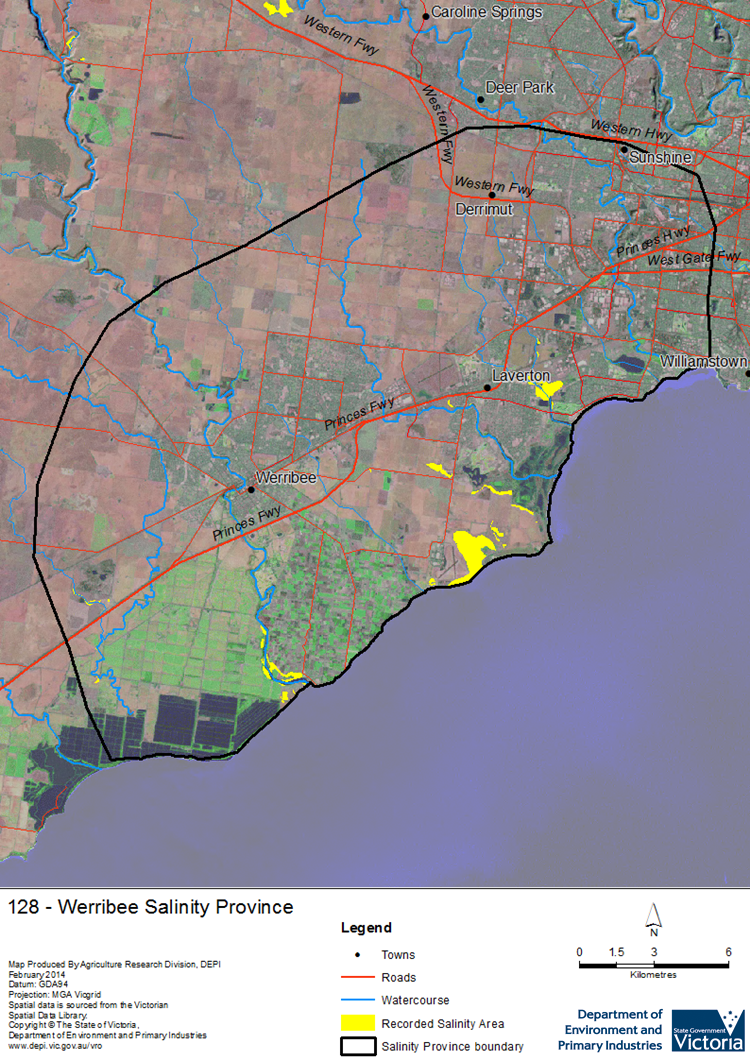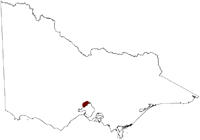Salinity Province 128, Werribee
|
|
Province Attributes
| Catchment Management Region: | PORT PHILLIP & WESTERNPORT |
| Priority Status: | High |
| Province Area: | 42670 ha |
| Recorded Soil Salinity Area 1: | 389 ha |
| Dominant Surface Geology Type: | Sedimentary |
| Influence of Geological Structure on Salinity Occurrence/s: | None |
| Relevant Geomorphological Mapping Units (GMUs): | 6.1.3, 6.2.5 |
| Predominant Groundwater Flow Systems (GFSs): | Regional, Local/Intermediate & Intermediate/Regional |
| Relevant Irrigation Areas: | Werribee |
Werribee Salinity Province Map

Links to further reading and material related to the Port Phillip and Westernport Salinity Province
Groundwater Flow Systems (GFS) in the Port Phillip & Westernport CMR
Port Phillip and Westernport CMA report "Salinity in the Port Phillip and Westernport Region – A reference document for councils, agencies, community groups and landowners to assist the management of salinity.” (May 2010)
For further information relating to groundwater levels and salinities in this Province please see: Visualising Victoria's Groundwater (VVG)
1 Please Note: The ‘Recorded Soil Salinity Area’ indicated in the Salinity Province Attribute Table, comprises the total geographic area that has been mapped as having, or showing symptoms of, dryland soil salinity at some time (past or present). As dryland salinity occurrence in the Victorian landscape exhibits many different levels of severity and can change due to climate, landuse and vegetation, previously mapped areas may no longer be showing symptoms. In addition, as not all parts of the State have been mapped, or mapped in the same way, the mapping may not have captured some occurrences.
The soil salinity mapping used to calculate this ‘area’ does not cover irrigation regions. In irrigation regions, depth to watertable and watertable salinity mapping has been used to convey the threat of high watertables on soil waterlogging and/or soil salinisation and these areas are not included in this ‘area‘ calculation.
Please contact the Department, your Catchment Management Authority or your rural water provider for more information about salinity in your location.

 The Werribee Salinity Province is a moderate sized province located on the western edge of the Melbourne metropolitan area. It covers about 10 km either side of the Princes Highway/Freeway from the suburb of Sunshine, to an area about 10 km west of the Werribee urban centre. About 20 % of the province is urbanised (mostly in the province’s east and centre), the remainder being a mix of small dryland agricultural enterprises (mostly grazing on improved pastures) and ‘Hobby Farms’. The small Werribee Irrigation Area is also located within the province, southwest of the Werribee urban area; landuse in this area involves intensive agriculture including flowers and vegetables. Being designated growth areas, major residential developments in the east and centre of the province are likely to have significant effects on its catchment hydrology and associated soil & water salinity.
The Werribee Salinity Province is a moderate sized province located on the western edge of the Melbourne metropolitan area. It covers about 10 km either side of the Princes Highway/Freeway from the suburb of Sunshine, to an area about 10 km west of the Werribee urban centre. About 20 % of the province is urbanised (mostly in the province’s east and centre), the remainder being a mix of small dryland agricultural enterprises (mostly grazing on improved pastures) and ‘Hobby Farms’. The small Werribee Irrigation Area is also located within the province, southwest of the Werribee urban area; landuse in this area involves intensive agriculture including flowers and vegetables. Being designated growth areas, major residential developments in the east and centre of the province are likely to have significant effects on its catchment hydrology and associated soil & water salinity.
